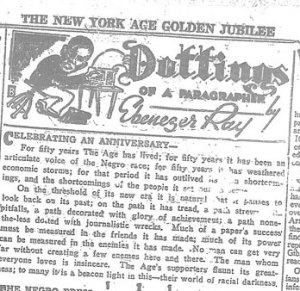If you plan to be in Pittsburgh between Feb. 11 and Oct. 2, check out “America’s Best Weekly: A Century of the Pittsburgh Courier,” which will be on exhibit at the Heinz History Center. The Courier, where my father worked when I was a young girl in Pittsburgh, is celebrating 100 years of service to the black community. In its heyday, the Courier had 400 employees and its readership spanned the country. The Courier was a strong voice against segregation and particularly lynching. Pullman porters were enlisted to surreptitiously “drop” the papers along their Southern train routes.
“These papers were not welcomed in those states and oftentimes were confiscated and destroyed to keep African-Americans from reading newspapers,” Samuel Black, the exhibit’s curator, said in a recent interview with CBS Pittsburgh.
Robert Lavelle, an old family friend, who as a young man was responsible for coming up with those delivery routes, was interviewed for The Black Press: Soldiers Without Swords, a film by award-winning filmmaker Stanley Nelson. Lavelle said that even though Pittsburgh was a relatively small city, the Courier had a name well beyond its borders “because it had tried to reach out to black people, no matter where they were, and we would try to send papers to those people. And as the people in those places became more numerous in terms of circulation, then those people would get a column in the Courier and maybe even on the front page of the Courier, and pretty soon that place had an edition of the Courier. So the Courier developed 13 editions and we would send papers to these various, regional places like the Midwest edition, the New England edition, the Chicago edition, the Philadelphia edition, and the Southern edition . . . We’d send them down by seaboard airline, Atlantic coastline railroad, down through Florida and all those places.”
On a personal note, my cousin Russell Williams recalls a visit his family made to Pittsburgh:
“Back in 1958, as my father finished his Ph.D. at Michigan State, we traveled back to South Carolina (where he taught at SC State), and we stopped in Pittsburgh to see Ebenezer and Mary Ray and their three daughters (Mary was my father’s favorite cousin). I remember Ebenezer taking us to the Pittsburgh Courier offices to show us how a newspaper was produced, and I carried home with me a souvenir (a piece of type) from that trip — a very interesting keepsake to my just-turned-seven-years-old
mind. Years later, I came to understand the important role that the Courier played nationally, and was very proud that I had a relative who had contributed to that impact.”
As I was four years old at the time and have no recollection of that visit, I was moved by Russell’s story.
Well before my father moved to Pittsburgh and joined the Courier, he tipped his hat to the Negro press as well. In 1935, the New York Age celebrated its 50th anniversary.
“For fifty years, The Age has lived; for fifty years it has been an articulate voice of the Negro race; for fifty years it has weathered economic storms; for that period it has outlived its own shortcomings, and the shortcomings of the people it set out to serve,” Ebenezer wrote in a column published Nov. 2, 1935. “On the threshold of its new era, it is natural that it pauses to look back on its past on the path it has tread, a path strewn with pitfalls, a path decorated with the glory of achievement; a path nonetheless dotted with journalistic wrecks. Much of the paper’s success must be measured in the friends it has made; much of its power can be measured in the enemies it has made. No man can get very far without creating a few enemies here and there. The man whom everyone loves is insincere. The Age‘s supporters flaunt its greatness; to many it is a beacon [of] light in this — their world of racial darkness.”










I stumbled upon your post while googling for images related to the Courier for the introductory slide of a powerpoint I’m doing as part of a genealogy workshop on the Courier in Ohio in the spring. Enjoyed the post and learned something important from the Lavelle quote that I will use in the workshop as well. I wrote a book Finding and Using African American Newspapers in 2008 in hopes of enlightening researchers on this valuable tool. Enjoy your day!
LikeLike
Here’s another article on the Heinz Center’s Courier exhibit from the Pittsburgh Post-Gazette: http://www.postgazette.com/pg/11042/1124540-51.stm?cmpid=newspanel1
LikeLike
My question is, Is there such a thing as the Black Press now and what is its role?
LikeLike